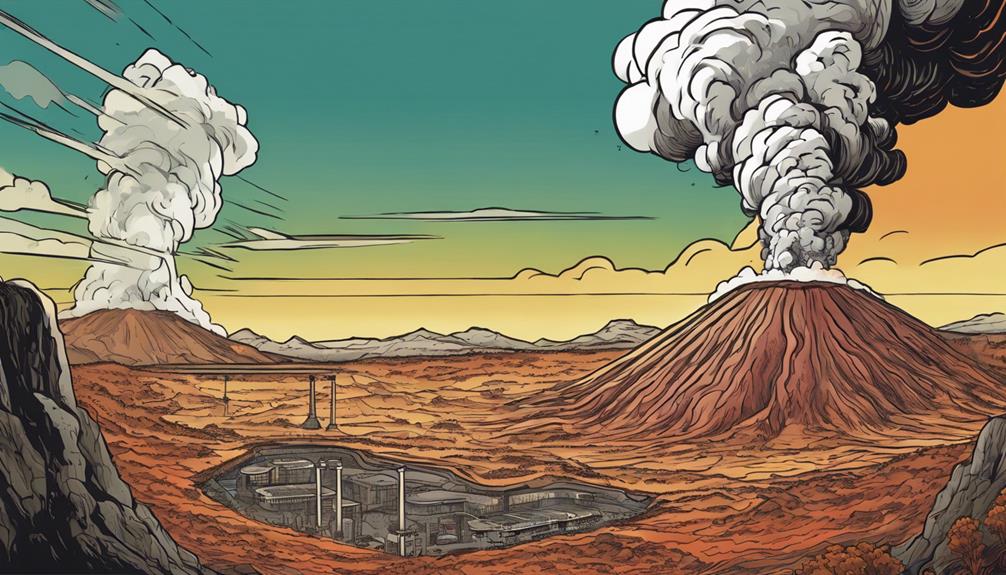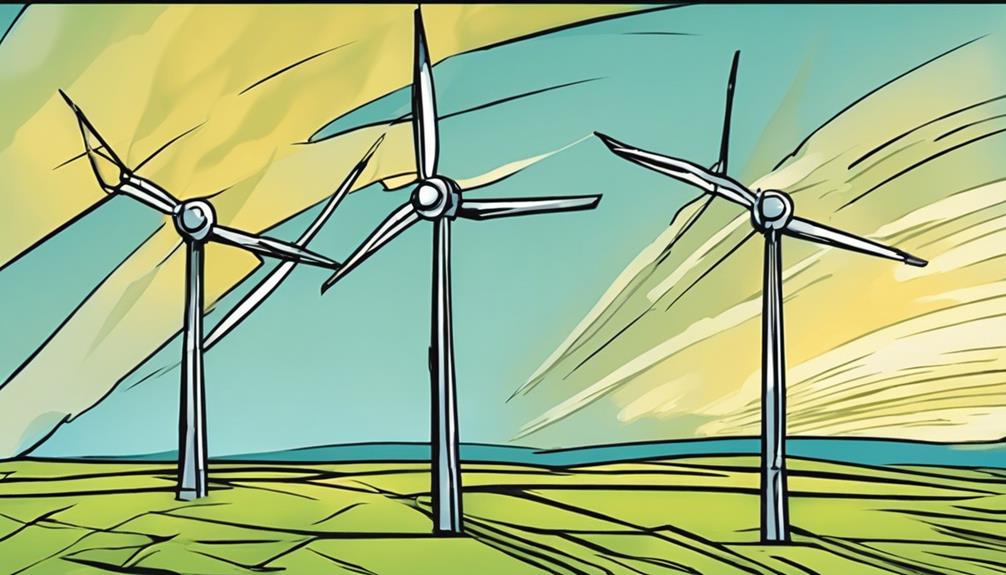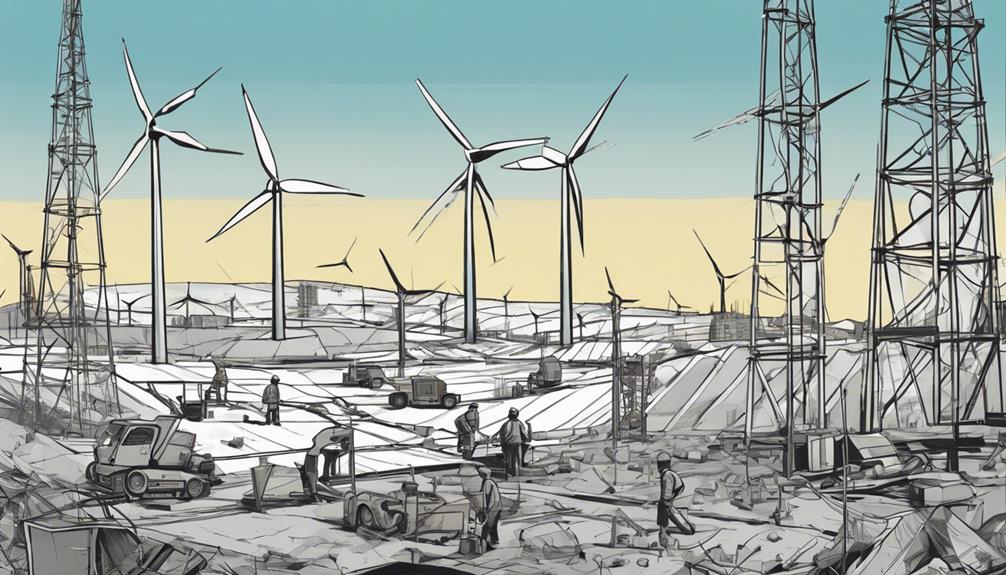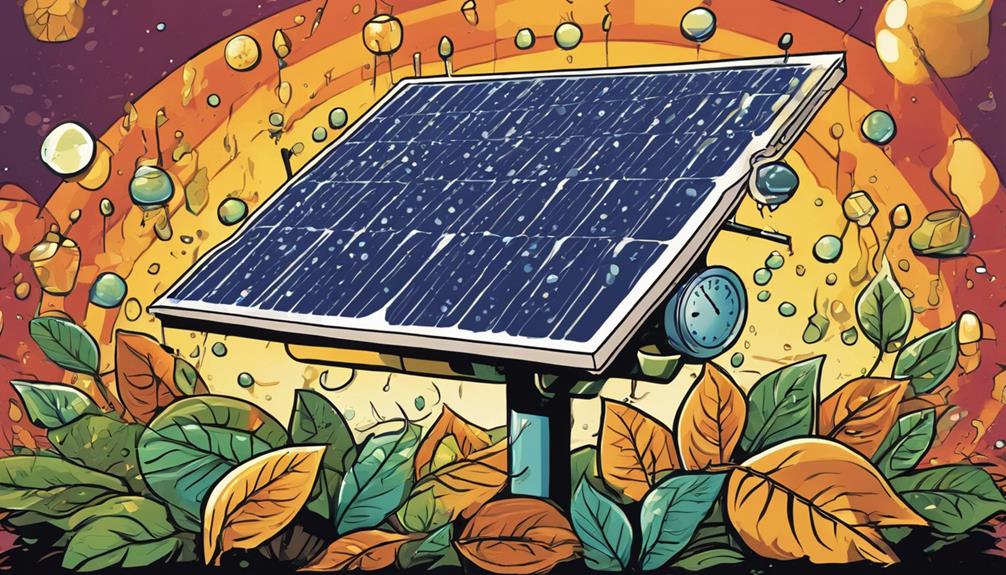To generate geothermal energy from volcanoes, we tap into hot water underground near volcanic areas. By running this hot water through high-temperature zones underground, we create steam for turbines that produce electricity. Drilling into hot rock layers captures rising steam, which is then used to power turbines efficiently. This method harnesses the intense heat from volcanoes to create sustainable energy. There are also benefits, challenges, and innovations surrounding volcanic geothermal energy that you may find interesting. See how utilizing this powerful energy source can help combat climate change and reduce reliance on fossil fuels.
Key Takeaways
- Harness hot water near volcanoes.
- Generate steam by running water through high-temperature areas.
- Capture rising steam by drilling into hot rock layers.
- Convert volcanic heat into electricity with turbines.
- Pump hot liquid or steam from underground for electricity.
Geothermal Energy Production From Volcanoes
Harnessing geothermal energy from volcanoes involves tapping into high-heat areas near volcanic regions to produce steam for electricity generation. This process is carried out through geothermal power plants located in volcanic regions.
These power plants utilize hot water from the underground reservoirs near volcanoes. By running this hot water through the high-temperature areas underground, steam is generated, which is then used to spin turbines for electricity production.
Volcanic geothermal energy is a sustainable and efficient method of generating electricity with minimal greenhouse gas emissions. The consistent heat provided by volcanic regions guarantees a reliable energy source that can power entire cities.
This form of energy production plays a pivotal role in the shift away from fossil fuels towards a more sustainable energy future. By harnessing the power of volcanoes, geothermal energy offers a promising solution for clean and renewable electricity generation.
Harnessing Volcanic Heat for Energy
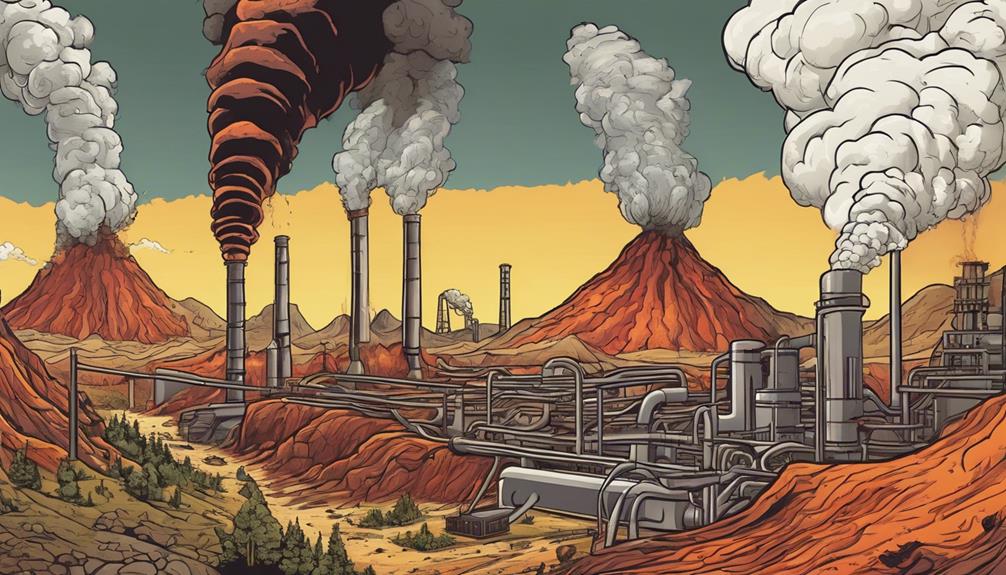
You can harness the immense heat produced by volcanoes to generate geothermal energy by drilling into hot rock layers and capturing the steam that rises.
This steam can then be used to power turbines, converting the volcanic heat into electricity.
Geothermal Heat Extraction
Extracting geothermal heat from volcanic regions involves pumping hot liquid or steam from underground reservoirs to power turbines for electricity generation.
In volcanic areas, geothermal energy is harnessed by drilling wells deep into the Earth to access the high-temperature fluids present underground. This process allows for the utilization of the natural heat from volcanoes to produce renewable energy.
Geothermal power plants near volcanic regions tap into this sustainable energy source, providing a consistent and reliable electricity supply. By capturing the intense heat near volcanoes, geothermal energy offers an environmentally friendly alternative that reduces reliance on fossil fuels.
The heat extraction process in geothermal power plants not only benefits from the Earth's volcanic activity but also contributes to the reduction of greenhouse gas emissions, making it a critical component of the renewable energy mix.
Harnessing geothermal heat from volcanic regions represents a significant step towards a cleaner and more sustainable energy future.
Volcanic Steam Power
Geothermal energy generated from volcanoes can be effectively utilized through the process of tapping into the steam produced by the intense heat of volcanic activity. Volcanic steam power is a key method in harnessing the heat and water resources near volcanic areas to generate electricity. By drilling into high-heat zones close to volcanoes, the steam necessary for turbines is accessed. This steam, created by running water through hot underground regions, powers turbines that in turn produce electricity. The process of utilizing volcanic steam power is both sustainable and efficient, offering a reliable and consistent source of energy. This method showcases how geothermal energy from volcanoes can be harnessed effectively to generate power for various applications.
| Aspect | Description | Importance |
|---|---|---|
| Utilization | Tapping into steam produced by volcanic heat for energy generation | Essential for power creation |
| Drilling Process | Accessing high-heat areas near volcanoes for steam required by turbines | Critical for energy production |
| Steam Generation | Running water through hot underground regions to create steam for driving turbines | Key for electricity generation |
| Sustainability and Efficiency | Demonstrates a sustainable and efficient way to utilize heat energy from volcanoes | Ensures long-term energy supply |
Benefits of Volcanic Geothermal Energy
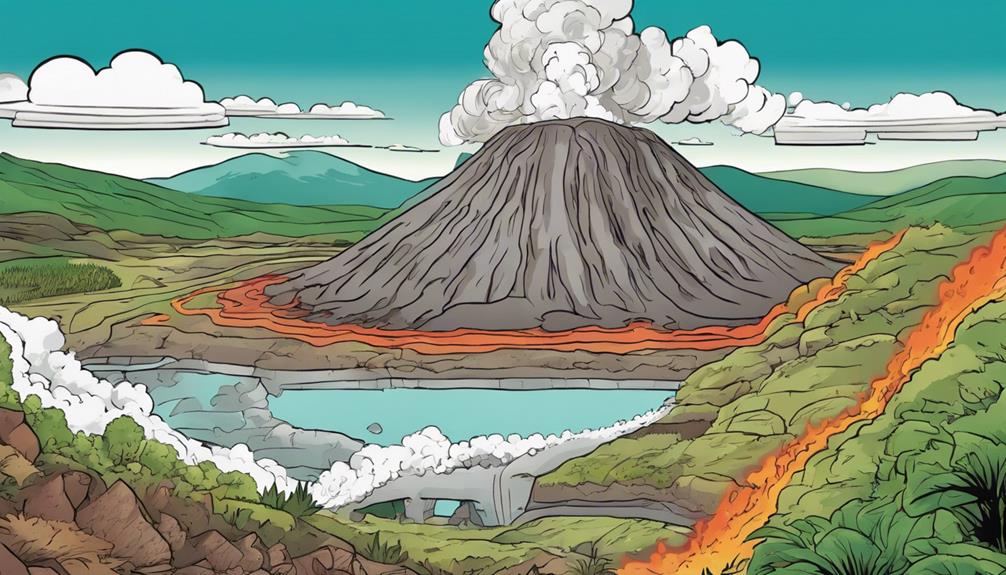
Harnessing geothermal energy from active volcanoes presents numerous environmental and economic benefits. This renewable energy source is a form of clean energy that can play an essential role in reducing greenhouse gas emissions. Countries like Iceland and New Zealand have already embraced the potential of geothermal energy from volcanic activity, showcasing its effectiveness as a sustainable energy solution. By tapping into the heat produced by volcanoes, significant strides can be made towards achieving a greener future.
The utilization of geothermal energy from volcanoes not only offers a reliable power source but also contributes to the global effort to combat climate change. Research focusing on volcanic geothermal energy aligns with Canada's ambitious goal of reaching net-zero emissions by 2050. Embracing this form of renewable energy can lead to a substantial decrease in reliance on fossil fuels, marking a significant environmental win in the pursuit of sustainable energy alternatives.
Challenges in Utilizing Volcanic Geothermal Energy

Exploring the complexities of tapping into volcanic geothermal energy presents substantial challenges that require innovative solutions for successful implementation.
When it comes to harnessing geothermal energy from volcanoes, the drilling process stands out as a major obstacle. Unlike non-renewable drilling, geothermal drilling demands a higher success rate due to the intricate nature of volcanic geothermal sources. This necessity for precision can make the drilling process costly and technically challenging.
To overcome these hurdles, researchers are actively engaged in enhancing success rates through techniques like advanced 3D mapping. By optimizing the drilling process, the efficiency of extracting geothermal energy from volcanoes can be notably improved.
Once these challenges are addressed and success rates are increased, the potential of harnessing clean energy from volcanic geothermal sources becomes more achievable. Ultimately, overcoming the obstacles in utilizing volcanic geothermal energy is vital for realizing its promise as a sustainable and environmentally friendly energy source.
Future Innovations in Volcanic Geothermal Energy
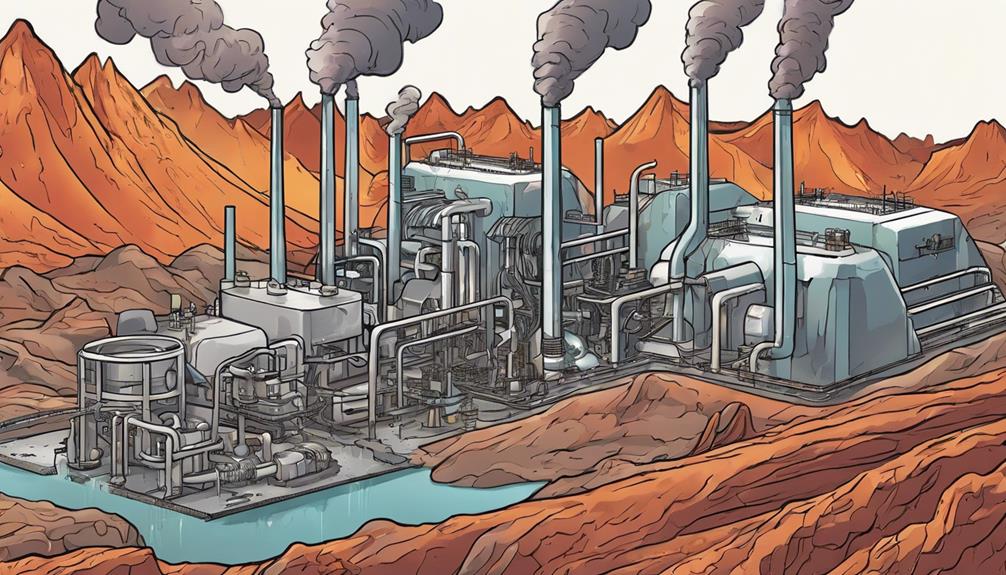
You can look forward to exciting advancements in geothermal technology tailored specifically for volcanic energy sources. These innovations aim to enhance the efficiency and sustainability of harnessing geothermal energy from volcanoes.
Stay tuned for developments that could revolutionize the way we tap into the immense potential of volcanic geothermal resources.
Innovative Geothermal Technology
The future of volcanic geothermal energy lies in the development of innovative technologies that enhance resource utilization and efficiency.
Enhanced geothermal systems (EGS) are a key focus for expanding the reach of volcanic systems for energy production.
Advanced drilling techniques are being honed to access deeper geothermal reservoirs near volcanic areas, maximizing energy extraction.
Improvements in reservoir engineering are essential for optimizing the efficiency of harnessing volcanic geothermal energy, ensuring sustainable power generation.
Additionally, the exploration of geothermal energy storage solutions is underway to enable more consistent electricity production from volcanic sources.
Integrating geothermal energy with other renewable sources like solar and wind is a promising avenue for creating a more robust and reliable energy grid.
The continuous advancement of innovative geothermal technologies holds great potential for unleashing the full power of volcanic geothermal energy in the coming years.
Enhanced Volcanic Energy Solutions
Future innovations in volcanic geothermal energy are poised to revolutionize the extraction and utilization of geothermal power from volcanic sources, focusing on enhancing efficiency and reducing costs. Enhanced energy solutions involve cutting-edge technologies tailored to optimize geothermal energy extraction specifically from volcanic environments. These advancements aim to make geothermal power plants more productive and economically viable, ultimately leading to a more sustainable energy future. Research in this field concentrates on refining drilling techniques and reservoir engineering to maximize resource utilization while minimizing environmental impact. Improved efficiency in harnessing volcanic geothermal energy could also enhance the resilience of geothermal power plants against potential disruptions caused by volcanic eruptions. Collaboration among experts in various fields is essential to drive the development and implementation of these enhanced volcanic energy solutions.
| Innovations in Volcanic Geothermal Energy |
|---|
| Advanced Drilling Techniques |
| Enhanced Reservoir Engineering |
| Sustainable Energy Generation |
| Increased Efficiency |
| Cost Reduction Strategies |
Geothermal Energy Advancements
Enhancing volcanic geothermal energy extraction methods through innovative technologies is a key focus of ongoing research and development efforts in the field. Advancements in geothermal energy from volcanoes are geared towards streamlining drilling processes for more cost-effective extraction and increasing efficiency in harnessing this renewable energy source. Future innovations aim to revolutionize the way we generate electricity, making geothermal energy from volcanoes a more prominent player in the mix of sustainable energy sources.
Researchers are actively exploring new technologies to improve the utilization of geothermal energy from volcanic sources. Enhanced mapping techniques are being developed to pinpoint prime locations for extracting geothermal energy efficiently and sustainably from volcanoes. The overarching goal is to establish environmentally friendly methods that maximize the potential of geothermal energy while minimizing the impact on the surrounding ecosystems.
Environmental Impacts of Volcanic Geothermal Energy
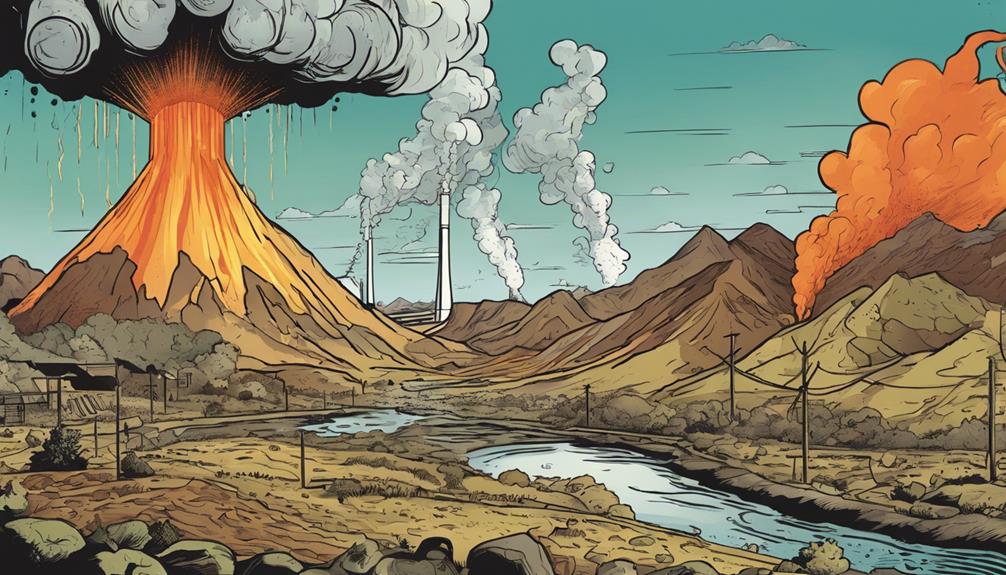
Harnessing geothermal energy from volcanoes can have minimal environmental impact compared to traditional fossil fuels. This sustainable energy source plays a pivotal role in combating climate change by reducing greenhouse gas emissions and promoting environmental conservation. Volcanic geothermal energy projects prioritize safeguarding air and water quality, ensuring that the surrounding ecosystems remain unharmed. By utilizing geothermal energy from volcanoes, natural landscapes and biodiversity are preserved, offering a sustainable alternative that minimizes environmental disturbances.
To illustrate the environmental impacts of volcanic geothermal energy, consider the following table:
| Environmental Impact | Description |
|---|---|
| Air Quality | Volcanic geothermal energy projects reduce air pollution by utilizing clean energy sources. |
| Water Quality | Strict measures are implemented to protect water sources from contamination, preserving water quality. |
| Ecosystem Conservation | Geothermal energy from volcanoes helps maintain biodiversity and protects natural habitats from disruption. |
Frequently Asked Questions
How Do Volcanoes Provide Geothermal Energy?
Volcanoes provide geothermal energy by harnessing the heat stored in magma. With temperatures between 650 and 1200°C, this energy source is abundant and accessible, offering a sustainable alternative for power generation.
How Is Geothermal Energy Generated?
You think geothermal energy magically appears? Nope. It's all about tapping into Earth's heat. Underground hot water or steam powers turbines, creating electricity. Volcanoes are nature's furnaces, giving you renewable, clean energy.
What Materials Make a Volcano a Good Source of Geothermal Energy?
To make a volcano a good source of geothermal energy, high temperatures and heat reservoirs in magma chambers are essential. The presence of magma and hot rocks near the surface allows efficient heat transfer to underground water reservoirs for energy production.
What Are the Two Ways to Generate Geothermal Energy?
You can tap into the Earth's fiery embrace in two ways: direct heating for cozy buildings and electricity generation from steam turbines. Volcanic geothermal energy provides sustainable power and warmth, harnessing nature's might.
Can Geothermal Energy Generated from Volcanoes Also be Converted into Electricity?
Yes, geothermal energy generated from volcanoes can be converted into electricity. This process involves harnessing the heat from volcanic activity and using it to produce steam, which then drives turbine generators to convert the geothermal energy transfer into electricity. Volcanic regions are ideal for tapping into this renewable energy source.
Conclusion
As you witness the power of volcanoes and the energy they produce, you can't help but feel a connection to the Earth's raw force.
Embrace the potential of volcanic geothermal energy and the innovations that lie ahead.
Despite the challenges, the benefits far outweigh the risks.
Let the fiery depths of the Earth inspire you to aim for a more sustainable future powered by the forces of nature.
